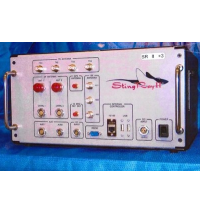Local Cops Throughout the State Use Anti-Terrorism Stingrays to Track Cellphone Users
 Harris Corporation's StingRay (photo: U.S. Patent and Trademark Office)
Harris Corporation's StingRay (photo: U.S. Patent and Trademark Office)
Local law enforcement agencies in California know a good thing when they see it. And “good thing,” in this case, means technology that allows them to track the mobil devices of unsuspecting individuals without court supervision by deploying hardware that mimics a cellphone tower.
A new map published by the American Civil Liberties Union (ACLU) shows the known locations nationally of where the agencies are using Stingray technology, but as the ACLU points out, it “dramatically under-represents” use of the surveillance equipment that the authorities fight to keep secret.
Wired Magazine reported that the ACLU was stunned two weeks ago when documents it requested from local police about use of Stingrays in Sarasota, Florida, were seized by the U.S. Marshall's Service before they could be released. Although federal authorities have fought to keep information about the controversial technology secret, the ACLU said this was the first time it had seen the feds mount a raid to to keep material away from the public.
An investigation earlier this year by USA Today, The Desert Sun in Southern California and other Gannett newspapers of 125 police agencies in 33 states discovered that at least 25 own a Stingray.
The ACLU map relies mostly on local reporting of Stingray sightings and includes police departments in Los Angeles, San Francisco, Oakland and San Jose, and sheriff's departments in the counties of Los Angeles, San Bernardino, Sacramento and San Diego.
LAPD got its Stingray back in 2006, according to LA Weekly, using U.S. Department of Homeland Security (DHS) funds, and used it 21 times during one four-month period. Cases included homicide investigations, three kidnappings, two attempted murders, two suicides, two missing persons, rape and narcotics.
Stingray is expensive hardware made by Harris Corporation that can be deployed in an area where the authorities are trying to track an individual. It pretends that it is a cell tower and fools wireless phones into establishing a connection. Once connected, it can determine cell location and download information of people who are not suspects in an investigation, raising all sorts of privacy issues.
Harris requires police departments to sign nondisclosure agreements that they are using the technology, making court oversight problematic. It also doesn't help that the Obama administration has been advising local authorities to obscure use of the the surveillance, which they have done.
The Associated Press, which has been thwarted in its attempts to access local public records about the use of Stingray, reported Thursday that interviews, court records and public-record requests indicate the feds have asked the locals to withhold basic information about how it works and how it is used.
The ACLU found that the devices, also known as IMSI catchers, are being used without a warrant or court order. In Florida, a police detective received permission to use a Stingray by filling out a routine “track and trace” application rather than seeking a probable-cause warrant, which is more difficult to obtain.
The government has argued for years that it doesn't need a warrant because the devices don't collect the content of phone calls. The FBI has said it doesn’t need a warrant because cellphone users have no reasonable expectation of privacy. The U.S.Supreme Court has not yet ruled on the issue.
ACLU attorney Nathan Freed Wessler described the longterm threat of having Stingrays deployed liberally throughout the country:
“Because we carry our cellphones with us virtually everywhere we go, stingrays can paint a precise picture of where we are and who we spend time with, including our location in a lover's house, in a psychologist's office or at a political protest. This sort of invasive surveillance raises serious questions about whether our tax dollars are funding violations of the U.S. Constitution's Fourth Amendment.”
–Ken Broder
To Learn More:
Local Cops in 15 US States Confirmed to Use Cell Tracking Devices (by Cyrus Farivar, Ars Technica)
Cops Urged to Stay Mum on Cellphone Tracking (by Jack Gillum and Eileen Sullivan, Associated Press)
Sting Operation: Police Tracked Cellphones with "Stingrays" (by Matthew Keys, The Blot)
U.S. Marshals Seize Cops’ Spying Records to Keep Them from the ACLU (by Kim Zetter, Wired)
Law Enforcement Officials: Cell Phone Disclosures Would Hurt Investigations (by K. Kaufmann, The Desert Sun)
LAPD Spied on 21 Using StingRay Anti-Terrorism Tool (by Jon Campbell, LA Weekly)
Local Police Departments Use Non-Disclosure Agreements to Hide Cellphone Tracking (by Noel Brinkerhoff, AllGov)
LAPD Uses Anti-Terrorism Devise to Track Cellphone Users (by Ken Broder, AllGov California)
- Top Stories
- Controversies
- Where is the Money Going?
- California and the Nation
- Appointments and Resignations
- Unusual News
- Latest News
- California Forbids U.S. Immigration Agents from Pretending to be Police
- California Lawmakers Urged to Strip “Self-Dealing” Tax Board of Its Duties
- Big Oil’s Grip on California
- Santa Cruz Police See Homeland Security Betrayal in Use of Gang Roundup as Cover for Immigration Raid
- Oil Companies Face Deadline to Stop Polluting California Groundwater





